Dr Akshai Mansingh | Risk and reward: Understanding sport bubbles
The COVID-19 pandemic had brought sport to a crashing halt. Initially thought to be a passing virus similar to chikungunya in Jamaica, it is now clear that this is a lingering virus and may be around for some years. The approach of halting all activities has to be replaced by a well-planned and executed mechanisms to resume activities of daily living, inclusive of sport.
The use of social bubbles allows increasing social contact while minimising the risk of virus spread. It takes groups of persons with limited risk profiles in a community and allows them to mingle. The biosecure bubble in sport is an athlete-centred approach recognising athletes as a community. Recognising that public health is of foremost concern, it allows for the resumption of limited sporting activity without significantly increasing risk of infection spread within that group. This starts with classifying sport themselves into risk groups. Those with minimal contact like golf, tennis and track and field are low-risk sports. Cricket and hockey are medium risk, whereas close-contact sports like football, netball and squash would be high risk. Clearly, the risk of virus spread increases across these categories.
The term ‘bubble’ is being used liberally without sometimes understanding the tenets required to maintain it. Through cricket, the region has developed expertise and a good reputation in planning and executing such bubbles. The West Indies tour of England was the first international sporting event since the pandemic, and the Caribbean Premier League (CPL) was the first international cricket league to resume. Both were successfully staged with no positive cases, but they were quite different in their construct.
The tour to England was a ‘contained bubble’ in which players from low-risk West Indies travelled to a country with one of the highest rates of COVID-19 at the time. All players tested negative prior to travel and were flown to England on a chartered plane, put into sanitised buses and taken to a hotel, which happened to be on the premises of the grounds. It was for this reason that Old Trafford and Southampton were selected. Players were tested on a weekly basis and came into contact with virtually nobody outside the bubble. They trained, practised and played in the same venue and then travelled as a team to the second venue where the same applied. Their opponents, as well as media, were themselves tested and isolated for a week prior to entering the bubble. All were tested before returning home on chartered planes.
The CPL bubble was a different challenge. It was held in Trinidad which was, at the time, COVID-19 free. More than 170 persons (players, support staff, match officials, administrators, broadcasting staff and journalists) from 18 countries, who all tested negative, entered the country on chartered planes and were similarly whisked away to a hotel for a two-week quarantine. Whereas the bubble would have been lifted thereafter, Trinidad had a second wave of infections, which necessitated the organisers to extend and reverse the bubble.
Initially, the CPL cohort were a risk to Trinidad. Now it was important to keep the community away from the cohort. Almost 50 local persons had to be incorporated. Additionally, this bubble had to be extended to training facilities and competition venues, where it was very important to separate the local staff and local journalists from the CPL cohort. Seven weeks and six tests later, all returned home safely.
NO SHORTCUTS
Though both bubbles were different, the principles were similar. This started by identifying safe venues and ensuring that safety could be maintained when moving between the different sites. This was followed by testing and isolating the cohort, which included players and all others involved that would be in close contact to each other. It was very important that these persons had limited contact with persons from the community. They were tested frequently. There also had to be protocols in place had anyone tested positive.
Most important was the observance of strict protocols of wearing masks when in the presence of others, frequent hand sanitisation and social distancing from all outside the bubble.
Any compromise to these principles will lead to increased risk of all within the bubble. For example, not testing players before bringing them into the bubble in a country such as Jamaica, which has community spread, would only increase the risk to all others in the bubble and the tests themselves would have to be reliable. Likewise, testing and then returning to the community renders that test only as good as to the time they re-enter their community, unless they are in strict isolation, not meeting anyone and not sharing transportation, etc. It is pointless having one team in isolation and the other not. All are placed at risk.
Forming and maintaining a sport bubble is not cheap and requires stringent monitoring and testing. It is also not comfortable for those in the bubble, as there are severe restrictions on activities and socialising. However, in the end, safety has to be of paramount importance and cannot be compromised. In doing so, no shortcuts can be taken. The decision to start a sporting competition outside of a strict bubble situation in present-day Jamaica places all involved at a risk. Whereas everyone wishes to see sport return, they must be cognizant of what is involved.
- Dr Akshai Mansingh is the dean in the Faculty of Sport at The University of West Indies. He also served as tournament chief medical officer for the recently concluded Caribbean Premier League.


